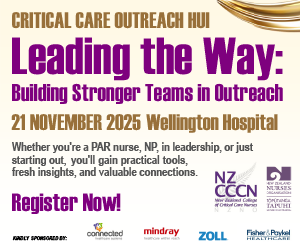
As a nurse, whether you work in primary or secondary care, you play a crucial role in supporting the independence of your older patients who live alone.
More older adults are living alone
The proportion of older adults living alone is increasing, largely due to population ageing.2,3 Just over 10 years ago, 44 per cent of New Zealanders living alone were aged 65 years or older.4 As the population continues to age, the number of New Zealanders projected to live alone is expected to increase 48 per cent by 2038, with 90 per cent of this growth occurring among adults aged 60 years or older.2
Living alone poses increased risks
Older adults living alone at home, either with or without comorbidities, are more likely to require emergency hospitalisation compared with older adults living with others.5
In one study, people living alone at home at the time of a stroke had delayed hospital arrival, received less thrombolytic therapy, and were less likely to return home compared with those who lived with others.6 Another study found that nearly 80 per cent of falls in older adults living in the community occurred when the person was alone and that 13 per cent had a “long lie” (on the floor for ≥1 hr), which is associated with serious clinical outcomes including hospital admission and subsequent need for long-term care.7
Furthermore, older adults who live alone can experience functional decline, which jeopardises their ability to live independently, following hospitalisation for an acute medical event.8
This reinforces the importance of having appropriate care plans in place for older adults who live alone, to support their safety and independence at home.
Support for older adults who live alone
Interventions that enable ageing in place while avoiding hospital admissions can help to support those living alone at home. Technology-based solutions, including use of a personal medical alarm, are a potential resource to facilitate older adults to live independently while providing health-related quality of life,9 especially for those with ongoing health conditions.10
Typical users of a personal medical alarm are older adults with an extensive medical history and who are often living alone.11 Benefits of personal medical alarms for older adults include accessing help faster and the confidence to maintain an active life.
Based on the findings of a cost analysis of emergency alarm activations due to falls or other acute medical events among older adults, triage-based personal medical alarms were advocated as a low-cost and effective intervention to support older adults who live alone.12
Identifying older patients who live alone
Older patients living alone are likely to have a higher level of health-care need.13
Whether you’re based in general practice, hospital or community, nurses are often in a unique position to identify older patients who may require additional support.
For those in general practice, patient data can be used to identify those living alone.14 It could also be that the screening of older patients’ health risk, or checking on their wellbeing and social function, provides the opportunity to enquire about their living situation (e.g. “Do you live alone?”).
For those managing the transition of older patients from hospital to home, pre-discharge assessments are important in identifying future risk, and additional support requirements, especially for those patients returning home to live alone.
A useful strategy to help enhance the emergency response time for your patients at home is to recommend a St John Medical Alarm. These simple yet powerful devices provide a 24/7 support system, giving your older patients the confidence to maintain their independence and remain in their own homes. In fact, the use of a personal medical alarm by community-living older adults has been associated with reduced requirements for hospital admission and fewer inpatient days compared with living without an alarm.15
Empowering your older patients to live safely while maintaining their independence
Your older patients living alone at home, especially those due for hospital discharge or at risk of a future medical event, can feel reassured knowing they can access help 24/7 in an emergency with a St John Medical Alarm. Referral is as easy as clicking a link in your Practice Management System (via Healthlink or ERMS) or online via stjohnalarms.org.nz/hcp. Access to a FREE trial is available to all patients.
For additional information visit: stjohnalarms.org.nz/hcp
References
- van Leeuwen, K., van Loon, K. M., van Nes, F. A., Bosmans, J. E., de Vet, H. C. W., Ket, J. C. F., Widdershoven, G. A. M., & Ostelo, R. W. (2019). What does quality of life mean to older adults? A thematic synthesis. PLoS One, 14(3), e0213263.
- Statistics NZ. (2015, Oct 29). Growth of one-person and two-person households driven by ageing population.
- Molinksy, J. (2020). The number of people living alone in their 80s and 90s is set to soar. Joint Center for Housing Studies of Harvard University.
- Statistics NZ. (2016). Two’s a crowd: Living alone in New Zealand.
- Barrenetxea, J., Tan, K. B., Tong, R., Chua, K., Feng, Q., Koh, W.-P., & Chen, C. (2021). Emergency hospital admissions among older adults living alone in the community. BMC Health Services Research, 21(1), 1192.
- Reeves, M. J., Prager, M., Fang, J., Stamplecoski, M., & Kapral, M. K. (2014). Impact of living alone on the care and outcomes of patients with acute stroke. Stroke, 45(10), 3083-5.
- Fleming, J., Brayne, C., & Cambridge City Over-75s Cohort Study Collaboration. (2008). Inability to get up after falling, subsequent time on floor, and summoning help: prospective cohort study in people over 90. BMJ, 17(337), a2227.
- Mahoney, J. E., Eisner, J., Havighurst, T., Gray, S., & Palta, M. (2000). Problems of older adults living alone after hospitalization. Journal of General Internal Medicine, 15(9), 611-9.
- Ollevier, A., Aguair, G., Palomino, M., & Simpelaere, I. S. (2020). How can technology support ageing in place in healthy older adults? A systematic review. Public Health Reviews, 41(1), 26.
- Agboola, S., Golas, S., Fischer, N., Nikolova-Simons, M., Op den Buijs, J., Schertzer, L., Kvedar, J., & Jethwani, K. (2017). Healthcare utilization in older patients using personal emergency response systems: an analysis of electronic health records and medical alert data. BMC Health Services Research, 17(1), 282.
- Stokke, R. (2016). The personal emergency response system as a technology innovation in primary health care services: An integrative review. Journal of Medical Internet Research, 18(7), e187.
- Wang, Y., Srikanth, V., Snowdon, D. A., Ellmers, S., Beare, R., Moran, C., Richardson, D., Lotz, P., & Andrew N. E. (2021). Quantifying the economic benefit of the personal alarm and emergency response system in Australia: A cost analysis of the reduction in ambulance attendances. Australian Health Review, 45(1), 51-8.
- Kharicha, K., Iliffe, S., Harari, D., Swift, C., Gillman, G., & Stuck A. E. (2007). Health risk appraisal in older people 1: are older people living alone an ‘at-risk’ group? British Journal of General Practice, 57(537), 271-6.
- Dreyer, K., Steventon, A., Fisher, R., & Feeny, S. R. (2018). The association between living alone and health care utilisation in older adults: A retrospective cohort study of electronic health records from a London general practice. BMC Geriatrics, 18(1), 269.
- Roush, R. E., Teasdale, T. A., Murphy, J. N., & Kirk, M. S. (1995). Impact of a personal emergency response system on hospital utilization by community-residing elders. Southern Medical Journal, 88(9), 917-22.
This advertising content was paid for by Hato Hone St John. Hosted content may not represent the views of Kaitiaki Nursing New Zealand nor the New Zealand Nurses Organisation.




